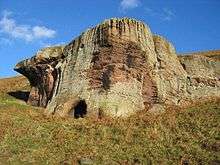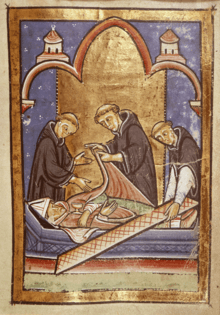St Cuthbert's Cave
St Cuthbert's Cave, known locally as Cuddy's Cave or Cove, can refer to one of two natural sandstone caves in Northumberland that have been traditionally associated with Saint Cuthbert, the seventh century Anglo-Saxon monk, bishop and hermit.
| St Cuthbert's Cave | |
|---|---|
| Native name Cuddy's Cave | |
 Cuddy's Cave, Doddington Moor, near Wooler | |
| Location | Northumberland |
| Owner | National Trust |
Doddington cave
The first cave, in sandstone, is situated near Doddington in Northumberland. It is a very small cave, which seems to have been artificially enlarged, but there is a tiny natural elliptic tube at the back.[1] Neolithic cup and ring markings, now no longer visible, were sketched there by George Tate in 1865 who wrote that, "On the scalp of the rock where it dips into the hill, four figures are traceable; but from being very much defaced, it is difficult to make out these forms, even when viewed under a favourable light."[2] Recent excavations, revealing extensive cup and ring markings, have been conducted at nearby Dod Law.[3]
Holburn cave

The second cave, also of sandstone, is situated in the Kyloe Hills near Holburn, between Belford and Lowick. The woodlands and cave are the property of the National Trust.[4] The cave is formed of overhanging rock, sufficiently large to provide shelter for a small group,[5] with a width of 24m and height of 3m. The back wall is 7m from the face and there is a natural rock pillar in the middle of the cave.[6]
Legend of St Cuthbert

According to the Anglo-Saxon Chronicle, in 875 as the Danes ravaged Lindisfarne and
"... destroyed all the monasteries. Eardulf, bishop of Lindisfarne, and abbot Eadred, taking the body of St Cuthbert from the island of Lindisfarne, wandered about for seven years."
According to legend, these caves might have been among the places in which either the monks took shelter with their holy relic or where Cuthbert himself lived as an anchorite hermit before moving to the Farne Islands.[7][8]
See also
- Vita Sancti Cuthberti (anonymous)
- Historia de Sancto Cuthberto
Notes
- Scaife, Chris: The Caves of Northumberland, Sigma Leisure, 2019
- Cuddy's Cave, Beckensall archive, University of Newcastle upon Tyne
- Dod Law, illustrated interactive guide, University of Newcastle upon Tyne. The project RAMP "Rock Art on Mobile Phones" allows exploration of these neolithic sites using information from a mobile phone as a guide.
- St Cuthbert's Cave. illustrated description of a circular walk from Belford
- English caves
- Scaife, Chris: The Caves of Northumberland, Sigma Leisure, 2019
- Colgrave 1985, p. 324
- Raine 1828, p. 21
References
- Raine, James (1828), Saint Cuthbert: With an Account of the State in which His Remains Were Found Upon the Opening of his tomb in Durham in the year 1827, G. Andrews
- Tate, George (1865), The ancient British sculptured rocks of Northumberland and the eastern borders: with notices of the remains associated with these sculptures, H.H. Blair
- Colgrave, Bertram (1985), Two Lives of St. Cuthbert, Cambridge University Press, ISBN 9780521313858